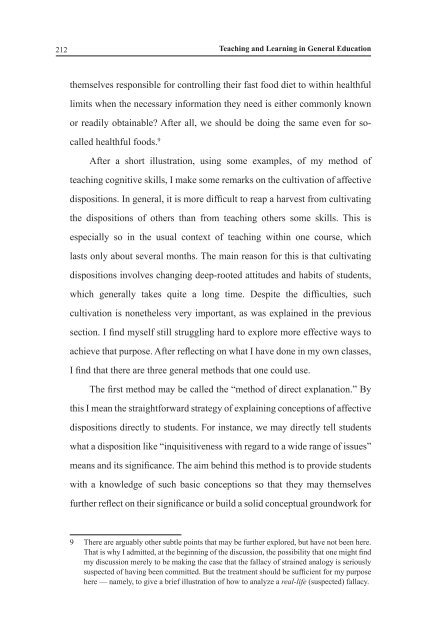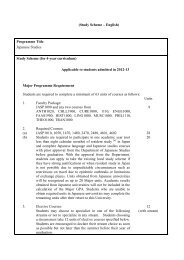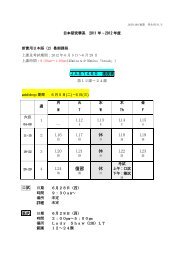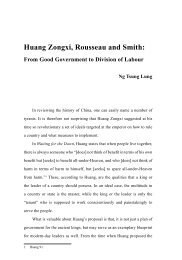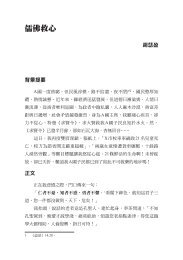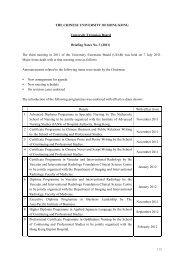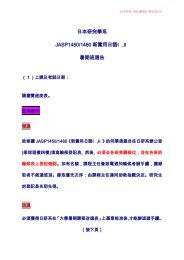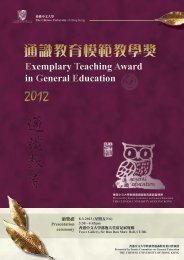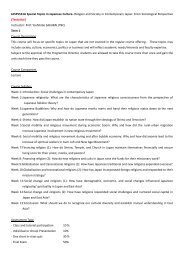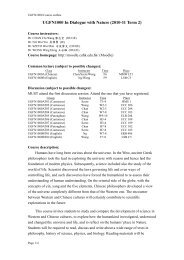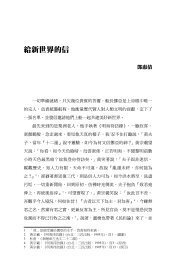ä¸è¼å ¨æ¸ - The Chinese University of Hong Kong
ä¸è¼å ¨æ¸ - The Chinese University of Hong Kong
ä¸è¼å ¨æ¸ - The Chinese University of Hong Kong
Create successful ePaper yourself
Turn your PDF publications into a flip-book with our unique Google optimized e-Paper software.
212 Teaching and Learning in General Education<br />
themselves responsible for controlling their fast food diet to within healthful<br />
limits when the necessary information they need is either commonly known<br />
or readily obtainable After all, we should be doing the same even for socalled<br />
healthful foods. <br />
After a short illustration, using some examples, <strong>of</strong> my method <strong>of</strong><br />
teaching cognitive skills, I make some remarks on the cultivation <strong>of</strong> affective<br />
dispositions. In general, it is more difficult to reap a harvest from cultivating<br />
the dispositions <strong>of</strong> others than from teaching others some skills. This is<br />
especially so in the usual context <strong>of</strong> teaching within one course, which<br />
lasts only about several months. <strong>The</strong> main reason for this is that cultivating<br />
dispositions involves changing deep-rooted attitudes and habits <strong>of</strong> students,<br />
which generally takes quite a long time. Despite the difficulties, such<br />
cultivation is nonetheless very important, as was explained in the previous<br />
section. I find myself still struggling hard to explore more effective ways to<br />
achieve that purpose. After reflecting on what I have done in my own classes,<br />
I find that there are three general methods that one could use.<br />
<strong>The</strong> first method may be called the “method <strong>of</strong> direct explanation.” By<br />
this I mean the straightforward strategy <strong>of</strong> explaining conceptions <strong>of</strong> affective<br />
dispositions directly to students. For instance, we may directly tell students<br />
what a disposition like “inquisitiveness with regard to a wide range <strong>of</strong> issues”<br />
means and its significance. <strong>The</strong> aim behind this method is to provide students<br />
with a knowledge <strong>of</strong> such basic conceptions so that they may themselves<br />
further reflect on their significance or build a solid conceptual groundwork for<br />
<br />
<strong>The</strong>re are arguably other subtle points that may be further explored, but have not been here.<br />
That is why I admitted, at the beginning <strong>of</strong> the discussion, the possibility that one might find<br />
my discussion merely to be making the case that the fallacy <strong>of</strong> strained analogy is seriously<br />
suspected <strong>of</strong> having been committed. But the treatment should be sufficient for my purpose<br />
here — namely, to give a brief illustration <strong>of</strong> how to analyze a real-life (suspected) fallacy.


